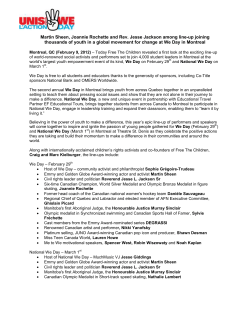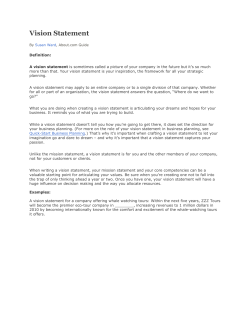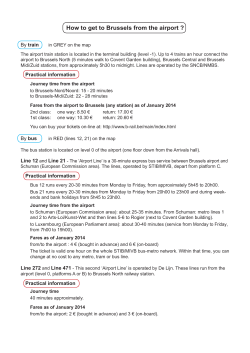
Document 192408
E C O N O M I C “Tax Policy” Series NOTE November 2006 HOW TO MAKE THE CANADIAN AIRLINE INDUSTRY MORE COMPETITIVE The airline industry has gone through plenty of turbulence over the last few years. Following a period of crisis caused by an economic slowdown in the United States and amplified by the attacks of 9/11, the SARS epidemic and the war in Iraq, air traffic began growing again in 2004. The airline sector remains fragile, however, and a jump in oil prices or new terrorist attacks could set things back again. Moreover, the high tax burden that Canadian air carriers are forced to bear compared to their U.S. rivals threatens their competitive position in a context of growing liberalization of airline markets. This Economic Note was prepared by Stéphanie Giaume, associate researcher at the Montreal Economic Institute, in collaboration with Martin Masse, director of research and publications at the Institute. Ms. Giaume has defended her doctoral thesis in economics at the University of Nice – Sophia Antipolis on a topic related to air transport. Long considered a luxury serving wealthy individuals or business travellers, air transport lies today at the heart of economic activity. In 2005, the production value of air transport reached $4.1 billion. The number of passengers using Canadian airports climbed to 63.7 million. The proportion of Canada’s foreign trade shipped by air reached 10.5% (5.6% of trade with the U.S. and 22.6% with other countries). Boats, trains and trucks accounted for the remainder. Overall, 79,700 persons worked in 2005 for airline companies, airport operators or various firms providing support services for air transport. This sector employs twice as many people as the railway sector and three times as many as the marine sector.1 Revenues rising Excluding general taxes applicable to all businesses, the specific contribution of the air transport sector to the federal treasury rose by an annual average of 19.6% between 2000 and 2005, reaching $793 million in 2004-2005. This sharp rise came mostly from the introduction in 2002 of the air travellers security charge introduced after the attacks of September 11, 2001. An examination of the amounts collected over the last five years gives a general idea of the extent of each tax, beyond major annual fluctuations. The air travellers security charge and airport rents account for 37% and 38% respectively of revenues collected from the airline sector. The federal aviation fuel tax represents a further 16% of revenues. Other federal taxes, namely other airport-related charges, aviation security fees and aircraft services, account for just 9% of government revenues (see Figure 1). The Government of Canada announced recently that it intends to conduct “open skies” negotiations with other countries, following agreements with the United States and the United Kingdom.2 Canadian air carriers thus risk finding themselves over the coming years in an environment in which they to face will have increasingly direct competition from their foreign rivals in progressively more open markets. In the context of instability that has marked the last few years, the federal government’s responsibility is to maintain a tax and regulatory environment favouring the competitiveness of Canadian air carriers. 1. Transport Canada, Transportation in Canada 2005: Annual Report, 2005, p. 11, Table 2-4 (production value) and p. 91, Table 9-1 (passenger traffic), available at http://www.tc.gc.ca/pol/en/report/anre2005/tc2005ae.pdf; Addendum, p. A102, Table A9-13 (trade) and p. A19, Table A2-23 (employment), available at http://www.tc.gc.ca/pol/en/report/anre2005/add2005-e.pdf. 2. Transport Canada, “Canada’s new government takes steps towards new international air policy,” Press release, October 25, 2006. See also two recent publications from the Montreal Economic Institute on this topic prepared by Pierre Jeanniot, Towards open skies for airlines in Canada, May 2005, available at http://www.iedm.org/uploaded/pdf/mai05_en.pdf and Canada and the liberalization of air transport markets over the Atlantic, June 27, 2006, available at http://www.iedm.org/uploaded/pdf/lepoint14_en.pdf. 16 % ECONOMIC 37 % NOTE FIGURE 1 % the Sources of federal government revenues 38 from aviation sector, 2000-2005 4% 2% In leaving other entities in charge of airport infrastructure, the government sought to make Canadian airports and airlines more competitive. However, rents are among the main obstacles to the competitive position of Canadian airports compared to U.S. airports, which face no similar cost. 3% 16 % Airport rents 37 % Other airport-related charges Aviation security fees The book value of infrastructure transferred since 1992 has been estimated by the Canadian Airports Council at $1.5 billion.4 Rents paid from 1996 to 2006 by NAS airports amount to more than $2 billion.5 If the airports had been privatized and carried mortgages rather than leases, the mortgages would be in the process of being paid off. Aircraft services 38 % Air travellers security charge Federal tax on aviation fuel 4% 2% 3% Source: Transport Canada, Transportation in Canada 2005: Annual Report (Addendum), Ottawa, 2005, p. A40, Table A3-4, available at http://www.tc.gc.ca/pol/en/report/anre2005/add2005-e.pdf and data provided Airport rents directly by Transport Canada. Other airport-related charges The various taxes that have been added to the already high fixed Aviation security fees costs of airline companies constitute a handicap compared to Aircraft services their main rivals, U.S. airlines, with the effect of these taxes Air travellers being felt directly in the pricesecurity of passenger tickets. charge Airport rents Federal tax on aviation fuel Montreal Ecomomic Institute Since 1992, the federal government has been pulling out of airport infrastructure, issuing 60-year leases that put airport management, development and operation under the control of local non-profit entities, together forming the National Airports System (NAS). These airports no longer receive any government subsidy. Their income comes from landing fees and general airport charges paid by airline companies, as well as commercial revenues from concessions and parking along with airport improvement fees collected from passengers.3 It is true that Ottawa is still the owner of the assets and that an owner normally collects rent from its tenants. But the federal government is not the same as an investor deriving income from its holdings, and it is not providing any administrative or maintenance service in exchange for the rents it is collecting. It amounts simply to a tax that passengers end up paying, with the revenue going directly to the public treasury. Moreover, this burden is shared unequally. In 2005, Pearson airport paid $144.4 million in rent, accounting for 27% of its operating expenses,6 while some airports pay no rent at all. Nearly the full amount comes from the airport administrations in Toronto (48%), Vancouver (27%), Calgary (9%) and Montreal (7%).7 Even if Pearson is Canada’s busiest airport, its 2004 market share came to only 31% of total traffic.8 What is pays in rent is thus far out of proportion to the traffic it generates. The high tax burden that Canadian air carriers are forced to bear compared to their U.S. rivals threatens their competitive position in a context of growing liberalization of airline markets. 3. These airport improvement fees are intended to pay for new facilities and vary from $10 to $15, depending on the airport. Revenues from these fees came to $416.3 million in 2004 (Transport Canada, Transportation in Canada 2005: Annual Report (Addendum), 2005, p. A95, Table A9-1). 4. Canadian Airports Council, “Issues with ground lease rent as a percentage of revenue,” January 2005, p. 2, available at http://www.cacairports.ca/news2/IssueswGroundLease04January2005.pdf. 5. Transport Canada, Transportation in Canada 2005: Annual Report (Addendum), 2005, p. A40, Table A3-4, available at http://www.tc.gc.ca/pol/en/report/anre2005/add2005-e.pdf. 6. Greater Toronto Airports Authority, Positioned to Deliver: 2005 Annual Report, available at http://gtaa.com/documents/news/AnnualReports/gtaa_2005_annual_report.pdf. 7. This is the 2004 share. Transport Canada, Transportation in Canada 2005: Annual Report (Addendum), 2005, p. A95, Table A9-1, available at http://www.tc.gc.ca/pol/en/report/anre2005/add2005-e.pdf. 8. Transport Canada, Transportation in Canada 2005: Annual Report (Addendum), 2005, p. A104, Table A9-17, available at http://www.tc.gc.ca/pol/en/report/anre2005/add2005-e.pdf. 2 HOW TO MAKE THE CANADIAN AIRLINE INDUSTRY MORE COMPETITIVE The air travellers security charge FIGURE 2 Rents collected by the government, 1996-2006 The air travellers security charge was instituted on April 1, 2002, to improve air transport security measures. During the first three years, this fee generated more than $1.25 billion in government income, compared to $820 million in spending. This amounts to $435 million in excess revenue that was not applied to improving security in air travel.11 350 300 300 Millions of dollars 288 250 214 200 248 To harmonize spending and revenues, the government agreed to reduce the charge in its latest budgets, but the Canadian Air Transport Security Authority will still have a surplus in 2008 estimated at $165 million.12 Even if this amount were to be reinvested eventually in security, it amounts at present to an advance charge on the air transport sector. Is it fair to ask today’s passengers to pay the cost of tomorrow’s security? 242 219 214 190 150 100 65 50 0 19961997 65 19971998 19981999 19992000 20002001 20012002 20022003 20032004 20042005 20052006 Source: Transport Canada, Transportation in Canada 2005: Annual Report (Addendum), 2005, p. A40, Table A3-4, available at http://www.tc.gc.ca/pol/en/report/anre2005/add2005-e.pdf. With a 6.9% rise in landing fees, Pearson in 2006 became the costliest airport in the world to land a Boeing 747, moving past Narita airport near Tokyo, which reduced its landing fees.9 The previous government announced on May 9, 2005, that it was committed to reducing rents and instituting a new form of calculation, to fully come into effect in 2010. Airport administrations will save $350 million over the next four years and $8 billion over the length of the existing leases.10 However, the rate used to calculate this is progressive and imposes a much greater tax burden on high-income airports, which will continue to pay a disproportionate share of rents collected by the government. Moreover, this reform does not resolve the issue of the competitive position of Canadian airports and airlines compared to their main U.S. rivals. Furthermore, this fee is another source of competitive disadvantage for Canadian air carriers in relation both to alternative modes of transport and to U.S. airline companies. While enhanced air travel security is paid for by passengers, rail and marine transport receive direct federal government assistance, without passengers having to pay any fee. Transport Canada has established a program contributing to marine safety, allocating $115 million over a three-year period (2004-2007).13 In November 2005, the federal government also announced $110 million in financing for measures aimed at improving security and safety in rail transport and public transit in Canada.14 Pearson in 2006 became the costliest airport in the world to land a Boeing 747, moving past Narita airport near Tokyo. HOW TO MAKE THE CANADIAN AIRLINE INDUSTRY MORE COMPETITIVE Montreal Ecomomic Institute 9. Air Transport Association of Canada, “Ranking of top 12 highest airport landing fees in 2004,” available at http://www.atac.ca/en/ourissues/advocacy/landing_fees.html, and CTV, “Pearson airport becomes world’s most expensive,” November 16, 2005, available at http://www.ctv.ca/servlet/ArticleNews/story/CTVNews/20051115/pearson_fees_051115/20051115?hub=TopStories. 10. Transport Canada, “Government of Canada cuts airport rents,” Press release, May 9, 2005, available at http://www.tc.gc.ca/medias/communiques/nat/2005/05-h098f.htm. 11. Canadian Department of Finance, “Updated Financial Information on Air Transportation Security,” available at http://www.fin.gc.ca/news06/06-041f.html#Donn%E9es. 12. The previous financial data come from the Department of Finance, “Updated Financial Information on Air Transportation Security,” available at http://www.fin.gc.ca/news06/06-041e.html. 13. Transport Canada, “Marine security funding program open for third round of applications,” Press release, April 28, 2006, available at http://www.tc.gc.ca/mediaroom/releases/nat/2006/06-h020e.htm. 14. Transport Canada, “Government of Canada announces new passenger rail and mass transit security initiatives,” Press release, November 23, 2005, available at http://www.tc.gc.ca/mediaroom/releases/nat/2005/05-h252e.htm. 3 ECONOMIC NOTE extra source of revenue at a time of record Following the 2001 attacks, the United States also deficits. While the funds collected have certainly imposed a fee to finance passenger security. The helped improve public finances, the deficit has September 11 Security Fee comes to US$2.50 been fully eliminated since 1998, and the tax no (equal to about C$2.80) per flight segment to a longer has the same pertinence. However, it is an maximum of US$5, with the fee not collected extra disadvantage for Canadian air carriers more than twice in the same itinerary. Added to compared to U.S. companies, which currently pay this is the Aviation Security Infrastructure Fee a fuel tax of about 4.3 U.S. cents a gallon, or (ASIF), also instituted in 2002 and charged about 1.3 Canadian cents a directly to airline companies litre.16 The U.S. tax is thus three using U.S. airports. Income times lower than the Canadian from ASIF brings the If passengers become less excise tax. government five to six times willing to absorb these costs, less than the September 11 there may be a migration to Conclusion Security Fee.15 Even adding less burdensome destinations these two fees, the burden or airports. imposed in the U.S. is lower The tax load weighing down the than in Canada, where the fees per segment charged to passengers range from C$4.95 for domestic flights to C$8.42 for transborder flights and C$17 for overseas flights. The federal excise tax on aviation fuel The federal aviation fuel tax was introduced in the 1985 federal budget and set at two cents a litre. In 1987, it doubled to four cents. This rate is still in effect, except for international flights, which are exempt as a consequence of a multilateral agreement. In 2005, this excise tax brought about $116 million into the federal treasury. To the federal taxes are added provincial fuel taxes, which vary from 0.7 to 15.2 cents a litre, depending on the province. Canadian airline industry is an obstacle to traffic growth in Canada. If passengers become less willing to absorb these costs, there may be a migration to less burdensome destinations or airports. Passengers may choose, for example, to transit through U.S. airports or to select a U.S. air carrier over a Canadian competitor, lured by the lower taxes added to the cost of a ticket. This burden also has negative effects on other sectors of the economy that depend heavily on air transport, such as tourism or foreign trade. Travelling by airplane is no longer a luxury, and the financial health of Canadian air carriers benefits the entire economy. In assessing ways of improving the competitive position of the Canadian airline industry, the federal government will have to plan on lowering this tax load, along with its policy of more open markets. The government’s motivation in introducing and increasing the aviation fuel tax was to provide an Montreal Economic Institute 6708 Saint-Hubert Street Montreal, Quebec Canada H2S 2M6 Telephone (514) 273-0969 Fax (514) 273-2581 Web site www.iedm.org The Montreal Economic Institute (MEI) is an independent, non-profit, non-partisan research and educational institute. It endeavours to promote an economic approach to the study of public policy issues. The MEI is the product of a collaborative effort between entrepreneurs, academics and economists. The Institute does not accept any public funding. One-year subscription to MEI publications: $98.00. Chairman of the Board: ADRIEN D. POULIOT President: PAUL DANIEL MULLER Director of Research and Publications MARTIN MASSE The opinions expressed in this study do not necessarily represent those of the Montreal Economic Institute or of the members of its board of directors. The publication of this study in no way implies that the Montreal Economic Institute or the members of its board of directors are in favour of or oppose the passage of any bill. Reproduction is authorized for non-commercial educational purposes provided the source is mentioned. Montreal Ecomomic Institute Montreal Economic Institute © 2006 Printed in Canada 15. U.S. Air Transport Association, “Overview of U.S. Aviation Taxes and Fees,” July 5, 2006, p. 3, available at http://www.airlines.org/NR/rdonlyres/A49D3845-0BAE-414B-9279-EE58B67FD913/0/ATATaxForWeb.pdf. 16. U.S. Air Transport Association, “U.S. Aviation Excise Taxes and Fees,” available at http://www.airlines.org/economics/taxes/excisetaxes.htm. 4 HOW TO MAKE THE CANADIAN AIRLINE INDUSTRY MORE COMPETITIVE Illustration: Benoit Lafond Graphic Design: Valna inc.
© Copyright 2025


















